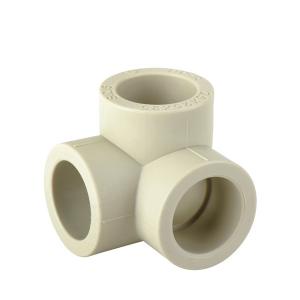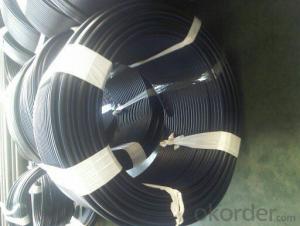1 1/2 Inch PPR Plastic Pipe Fittings for Industrial and Agricultural Fields Made of PPR Materials
- Loading Port:
- Tianjin
- Payment Terms:
- TT OR LC
- Min Order Qty:
- 1000 pc
- Supply Capability:
- 100000 pc/month
OKorder Service Pledge
OKorder Financial Service
You Might Also Like
Introduction of Products
Distribution for cool and hot water Duct for drinkable water system Pipes for kinds of
high-temperature and low-temperature heating system Pipes for heating and cooling
settings in solar energy system Connecting pipe for air conditioners
Size
Normal Sizes for CNBM PPR Pipe | |||||
Outside Diameter(mm) | Wall Thickness(mm) | Package(m/bale) | |||
S5 PN1.25MPa | S4 PN1.6MPa | S3.2 PN2.0MPa | S2.5 PN2.5MPa | ||
20 | 2 | 2.3 | 2.8 | 3.4 | 120 |
25 | 2.3 | 2.8 | 3.5 | 4.2 | 120 |
32 | 2.9 | 3.6 | 4.4 | 5.4 | 80 |
40 | 3.7 | 4.5 | 5.5 | 6.7 | 60 |
50 | 4.6 | 5.6 | 6.9 | 8.3 | 40 |
63 | 5.8 | 7.1 | 8.6 | 10.5 | 24 |
75 | 6.8 | 8.4 | 10.1 | 12.5 | 16 |
Products Show



Packaging Details
1. Large carton: 515 x 400x 220 Cubage: 0.04532 M3
Small carton: 390x255x250 Cubage: 0.0248 M3
2. PE poly bag+ carton Delivery Detail: 15 days/ 20" containers; 25 days/ 40HQ
Product Advantages
1) Healthy, bacteriological neutral, conforming to drinking water standards
2) Resistant to high temperatures, good impact strength
3) Convenient and reliable installation, low construction expenses
4) Excellent heat-insulation property from minimum thermal conductivity
5) Lightweight, convenient to transport and handle, good for labor-saving.
6) Smooth inner walls reduce pressure loss and increase flow speed
7) Sound insulation (reduced by 40% compared to galvanized steel pipes)
8) Light colors and excellent design ensure suitability for both exposed and hidden
installation
9) Recyclable, environment-friendly, accords with GBM standards
FAQ
Q: What you offer?
A: Any kinds of goods you need, just send us the request, we will reply you back with the
details very soon.
Q: Product quality and delivery time?
A: Normally 7-15 days after the order confirmed, we will collect the goods and inspect each
of the items and send you the inspection photos for you to confirm.
Q: What's the regular shipping port?
A: Tianjin, Shanghai.
Q: What's your payment?
A: T/T,L/C,D/P,D/A
- Q: Are plastic pipe fittings resistant to thermal expansion and contraction?
- Yes, plastic pipe fittings are generally resistant to thermal expansion and contraction. Unlike metal fittings, plastic materials have a greater ability to expand and contract without undergoing significant dimensional changes or structural damage. Additionally, plastic pipes and fittings have lower thermal conductivity, which further helps in minimizing the effects of temperature fluctuations. However, it's important to consider the specific type of plastic used in the fittings, as different materials may exhibit varying degrees of resistance to thermal expansion and contraction.
- Q: Can plastic pipe fittings be used for HVAC systems?
- Yes, plastic pipe fittings can be used for HVAC systems. They are commonly used in both residential and commercial HVAC installations due to their durability, versatility, and cost-effectiveness. Plastic fittings are resistant to corrosion, lightweight, and easy to install, making them a suitable option for various HVAC applications. However, it is important to select fittings that are specifically designed for HVAC systems and comply with relevant codes and standards to ensure proper functioning and safety.
- Q: Are plastic pipe fittings resistant to high humidity environments?
- Yes, plastic pipe fittings are generally resistant to high humidity environments. They are designed to withstand moisture and are often made from materials such as PVC or CPVC, which have inherent moisture resistance properties. However, it's important to consider the specific type of plastic used and the quality of the fittings, as some may have limitations in extreme humidity conditions.
- Q: Can plastic pipe fittings be used for industrial cooling systems?
- Yes, plastic pipe fittings can be used for industrial cooling systems. Plastic fittings are commonly used for various industrial applications including cooling systems due to their durability, corrosion resistance, and cost-effectiveness. However, the suitability of plastic pipe fittings for a specific cooling system should be determined based on factors such as temperature, pressure, and the specific requirements of the system.
- Q: Are plastic pipe fittings suitable for radiant floor heating installations?
- Yes, plastic pipe fittings are suitable for radiant floor heating installations. They are commonly used in such systems due to their flexibility, durability, and resistance to corrosion. Plastic fittings are also easier to install and less expensive compared to metal alternatives.
- Q: Are plastic pipe fittings compatible with flange connections?
- No, plastic pipe fittings are not generally compatible with flange connections. Flange connections are typically used for joining metal pipes, while plastic pipe fittings are designed for use with plastic pipes and utilize different connection methods, such as solvent welding or compression fittings.
- Q: Are plastic pipe fittings resistant to acid solutions?
- Yes, plastic pipe fittings are generally resistant to acid solutions.
- Q: Do plastic pipe fittings require any special reinforcement or clamping?
- Yes, plastic pipe fittings typically require special reinforcement or clamping to ensure a secure and leak-free connection. This is necessary to prevent any potential leaks or failures in the system.
- Q: Can plastic pipe fittings be used for irrigation systems in cold climates?
- Yes, plastic pipe fittings can be used for irrigation systems in cold climates. Plastic fittings are known for their durability and ability to withstand freezing temperatures. However, it is important to choose fittings made from materials that are specifically designed for cold weather conditions, such as PVC or polypropylene, to ensure they do not crack or break due to freezing temperatures. Additionally, proper insulation and drainage techniques should be employed to prevent water from freezing inside the pipes and causing damage.
- Q: Are plastic pipe fittings resistant to mold and mildew?
- Yes, plastic pipe fittings are generally resistant to mold and mildew as they do not provide a suitable environment for their growth.
Send your message to us
1 1/2 Inch PPR Plastic Pipe Fittings for Industrial and Agricultural Fields Made of PPR Materials
- Loading Port:
- Tianjin
- Payment Terms:
- TT OR LC
- Min Order Qty:
- 1000 pc
- Supply Capability:
- 100000 pc/month
OKorder Service Pledge
OKorder Financial Service
Similar products
Hot products
Hot Searches
Related keywords




























